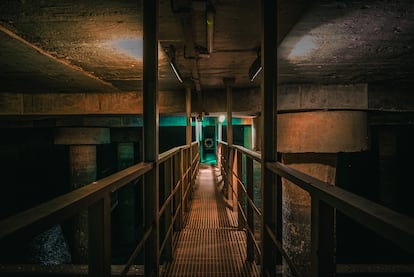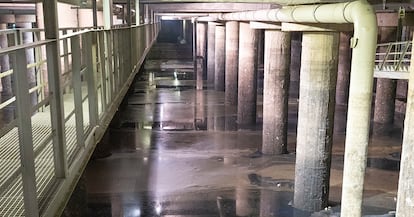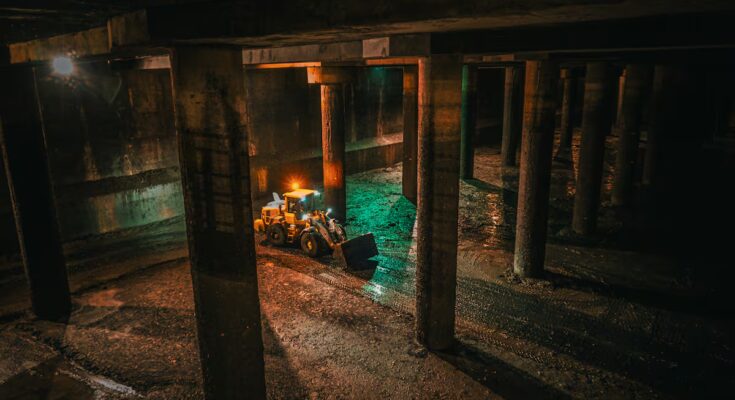They are processes so common that they seem simple. Open the kitchen or bathroom faucet and let the water run out. Flush the toilet and make your bowel movements disappear. Most people don’t know what makes these everyday gestures possible. But behind the sanitation systems there is an entire infrastructure invisible to the eyes of citizens that performs an essential function to minimize flooding in case of rains and prevent pollution of nearby rivers.
On days of heavy or continuous rain, storm cisterns are tasked with storing the first water that falls from the sky and pose some risks due to the pollution they carry. These pillars, built beneath cities, hold liquids until treatment plants have the capacity to clean them. In 2024, the latest year with available data, they contained more than 8,000 million liters of dirty water, in Madrid alone.
Canal de Isabel II, the body responsible for the 16,000 kilometers that make up the sanitation network of the Community of Madrid, manages more than 70 reservoirs in the region. 38 of which are located in the capital, where their function is clearly appreciated: thanks to their effective systems, they prevent pollution from reaching the Manzanares River and prevent the discharge of untreated water.
The community also owns two of the largest reservoirs in the world: Arroyofresno and Butarque, with a capacity of 400,000 meters each. They are the most important infrastructures of a region that has 155 purification plants and almost two hundred pumping stations, essential on days of heavy rainfall.
This is how a storm tank works
There is a fact that many citizens are unaware of. Not only wastewater from homes, businesses and industries circulates through urban drainage networks. In cases like Madrid, which has unitary networks, they are also responsible for collecting rainwater to send it to treatment plants. There they are treated before being returned to the rivers in optimal condition so that they do not contaminate their ecosystems.
The wastewater flow remains more or less fixed, but problems can occur during periods of heavy rainfall. In these episodes of high rainfall, the large amount of water may exceed the capacity of some treatment plants. That’s when storm tanks come into play.
These huge tanks regulate the passage of rainwater to the purification plants, preventing capacity from being exceeded and preventing excess water from being discharged without being treated. An example: if they did not exist, in periods of very intense rainfall, the purifiers would not be able to accommodate all the flow received, therefore they would be forced to divert the excess water, without purification, to the rivers. Thanks to the role of the tanks, which prevent or minimize possible environmental impacts, its natural cycle is not influenced.
Reserving rainwater until it can be treated generates added value. The first rains wash away all the dirt accumulated on the streets, such as pet excrement, vehicle oils or solid waste from the ground (for example), which is pushed into scuppers and sewers. Preventing the spread of pollution solves a worrying fact: in some places, runoff water during the first hour of rain is even more harmful to the environment than residual water in dry weather, as found by a study of the Canal de Isabel II.

Before reaching the tanks, the water passes through a series of filters that retain solid waste. Those that manage to overcome that barrier – bottles, plastic bags… – remain accumulated on the bottom or surface of the body of water. So, although the reservoirs represent a shield against pollution of river channels, Canal Isabel II insists that the best way to reduce risks is to implement responsible surface management in cities: use rubbish bins on public streets and, above all, do not throw wipes or other waste down the toilet. It is good to remember that only conventional toilet paper should be thrown into the toilet.
The Madrid network, one of the largest in the world
Unlike other capitals such as Paris or London, which have large rivers (Sine and Thames), in Madrid the Manzanares river channel is scarce and its self-purification capacity is very limited. Therefore it is important, especially in the urban section, to have a network of tanks.
The more than 70 that Canal de Isabel II manages in the Community amount to a total capacity of 1.40 cubic hectometers (hm3), equivalent to 25 times the water accumulated in the Retiro Park pond. This figure will grow in the coming years thanks to the investments that the public company will undertake in its 2025-2030 Strategic Plan. Of the total number of operational tanks, last year the 38 structures distributed in the municipal area of the capital maintained 8.3 hm.3 of dirty water, preventing them from ending up in the Manzanares.
Six keys to understanding the Arroyofresno tank

1
The first rainwater they drag accumulated pollution to the surface of the city

2
Excess water circulating through the sewer system It is diverted to the reservoir through a collector more than three kilometers long and with a diameter of almost seven meters.

3
The liquid reaches the compartment with the smallest capacity of the tank

4
If the rain is heavier than normal, and is exceeded, the water is eliminated go to the second compartment

5
This allows the filling of 400,000 meters cube of water

6
The tank is equipped with emptying pumps. Once the storm is over, redirect the water to treatment facilities so it can be cleaned.
One of the most emblematic and well-known facilities in the capital is the Arroyofresno reservoir, north-west of the city. It is located within the Villa de Madrid Country Club and receives, during episodes of strong storms, surplus water from the municipalities of Fuencarral-El Pardo, Tetuán, Chamartín and Moncloa, for this reason it acts as a shield for approximately 700,000 residents.
The Arroyofresno reservoir has a surface area of 35,000 square meters and descends to a depth of 22 meters, which are in turn divided into two floors: the lower one, approximately 10 meters, accumulates the water, while the upper one houses the control room. The total volume of the underground construction includes approximately 750,000 cubic meters (m3) of which 400,000 used for water storage.

The body of the tank is separated into two compartments thanks to a 246 meter long screening wall. In this way the water initially fills the compartment with the smallest capacity. If the precipitations are more abundant than ordinary storms and cover it completely, the water overcomes the wall and allows the total filling of the 400,000 m3. The separation between the two areas makes maintenance and cleaning easier and more operational.
When it rains, the water reaches this reservoir through a collector more than three kilometers long, under the Manzanares River and large infrastructures such as the M-30 highway. The most impressive element of its design is the diameter: almost seven meters allowing a flow of water up to 100 m3 per second, i.e. 30 times higher than the average flow rate of the river. In addition, the facility has pumps that allow it to be emptied and, at the end of a storm, can divert the water to collectors on the banks of the Manzanares River so that the liquid can be transported to the Viveros treatment plant – the closest – or to other sanitation facilities more distant.



